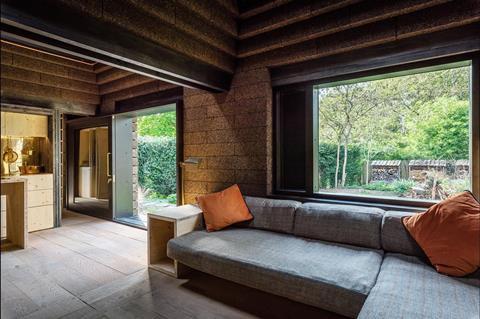Materials are not just about applied finishes. By thinking about their structural, thermal and acoustic qualities, we can use them more effectively, writes Alex Lynes

In the contemporary built environment sector, it can be easy to prioritise client desires and aesthetic sensibilities over the effective use of materials, which is increasingly important in the era of a climate emergency.
Originally, the question of what material to use and how to use it was very simple. The number of construction materials were limited, and local ones were cheap. If you wanted to look fancy, then you would pick one that wasn’t local and you would stand out.
Stone houses in timber areas, or brick houses in stone areas, were a sign of status. The question of how to use the material was obvious. Stone walls were made from stacking stone, timber floors were made by spanning timbers across spaces, clay was used for filling in gaps.
What else would you do with those materials? But, as construction methods got more complex, the options grew. Timber could be used or stud walls, stone could be used for vaults, iron or steel could be shaped to do either.
When designers found that materials could be made to do whatever they wanted them to do, the dynamic changed. Over the last hundred years or so, material has been treated almost as an afterthought - something to select once the layout and look of the building has been decided.
Good designers can select the right material for the job, great designers select materials for multiple overlapping uses
We are limited in the materials we can use, so it is the responsibility of clients and designers to use them in the most effective way. It is the architects and engineers of the world that hold the lion’s share of this responsibility.
By their hands, concrete has become the second most abundant material on earth after water. This is irresponsible at best, reckless at worst. We must now see it as our duty to carefully, efficiently and effectively select and use materials for the long-term health of the planet.
But how do you use materials effectively?
Fundamentally, materials are all different. This may seem odd to say but it really does need saying. Can we make that column out of glass? Potentially, but do we really want to? We have become so used to seeing materials as a palette of colours, rather than the box of tools that they are.
You need a detailed understanding of the materials, their properties, manufacturing techniques, sources, construction methods, benefits and limitations. Good designers can select the right material for the job, great designers select materials for multiple overlapping uses.
There are plenty of examples out there of buildings starting to use their materials more effectively
If material selection is seen as part of the design process of the building, rather than simply stylistic or surface-led, then the building can develop in line with its materials. Once you see materials as an intrinsic part of the building, you can ask what it offers and whether it can be used better.
This pushes you to take advantage of everything it can do rather than just the one job you may pick for it otherwise. What are the thermal and acoustic properties of structural materials? What are the structural properties of the finishes? How can you minimise material use by understanding the fabrication process?
There are plenty of examples out there of buildings starting to use their materials more effectively. The use of concrete slabs for thermal mass is the obvious example. A much more efficient use of concrete is a ribbed or waffle slab, as opposed to commonly use flat slabs, and they actually provide even better thermal mass because of increased surface area.
Mass timber buildings that expose and express the structural form are also steps in the right direction. Exposing the timber not only reduces additional finishes, but also modulates the humidity and dampens sound and vibrations. Timber also provides some insulation and a continuous wall of it has no thermal bridging.
Using materials more effectively also means considering the fact that CLT poses its own challenges: it is difficult to co-ordinate with building services, and using CLT for sound or thermal insulation can be structurally inefficient. Thinking laterally, studwork panels or SIPS sandwich panels, in comparison, use significantly less timber and provide more insulation as part of the panel while retaining the prefabricated format and speed of construction.

A really great example of this principle is Cork House, a private home that uses cork as its primary material. By understanding the material properties and its manufacturing process, the designers developed a construction system that enabled the cork to be used as the load bearing structure, insulation, finishes (external and internal), and as a vapour and moisture control layer.
It’s a standout example of what you can end up with if the material comes first, and you allow the design to come from it, rather than the other way round.
Our work with structural stone is also striving to do this, bringing stone back from being only a cladding to using its high compressive strength, thermal mass and low carbon more effectively. It is a process that we’re still interrogating, from the differing forms of our Clerkenwell Place stone exoskeleton project with Groupwork, to more recent installations and residential work with beams and slabs.
Understanding the properties of materials and building a knowledge base of tested examples is where construction industry professionals really add value. Moving towards a net zero world will likely push us to remember these skillsets and apply them.
Postscript
Alex Lynes is an associate director at Webb Yates Engineers
















No comments yet